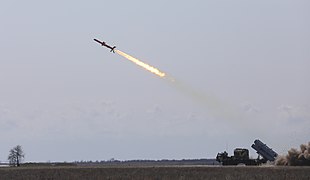R-360 Neptune

Neptune (Template:Lang-uk) is an Ukrainian cruise anti-ship missile under development by Ukroboronprom. Expected to be mounted on three platforms: ship, land and air launches.[1]
The prospective missiles will be located in transport and launch containers (TLC) with dimensions of 5,300 × 600 × 600 mm. The length of the rocket itself with an accelerator of 5,050 mm. TLC with a rocket with a cross-shaped hard wing can be placed on terrestrial, marine or air carriers.
It is intended to defeat combat surface ships and transport vessels from the structure of shock groups (convoy) or moving individually with a displacement of up to 5,000 tons.
The missile is based on a design of the Soviet anti-ship missile Kh-35, however Ukrainian constructors substantially improved missile range and electronics.[2]
History
The missile was revealed for the first time in the exhibition "Weapons and Security 2015" which held in Kyiv.[3]
According to information from open sources, the first flight samples of the cruise missile were manufactured in the spring of 2016. Production of advanced missile weapons takes place in cooperation with other Ukrainian enterprises, including Artem Luch GAhK, Kharkiv State Aviation Plant, «Motor Sich» (turbofan MS-400 engine), Pivdenne YuMZ PivdenMash, Lviv LORTA or other radar electronics, Vyshneve ZhMZ Vizar Kiev and others.
March 22, 2016, the first tests of the Neptune missile were conducted. The tests were attended by secretary of NSDC of Ukraine Oleksandr Turchynov. In mid-2017, missiles were tested concurrently with trials of the Vilkha complex. However, unlike the Vilkha, the test results and capabilities of the "Neptune" rocket were not advertised.[4] On January 30, 2018, according to the press service of NSDC, the first flight tests of the Ukrainian ground-based cruise missile, which is capable of accurately hitting ground and naval targets, were successful.[5] On August 17, 2018, the missile successfully hit a target at the range of 100 km during test fire in the southern part of Odesa oblast.[6] 6 April, 2019, the missile was successfully tested again and hit target during tests near Odesa, according to President Petro Poroshenko's statement, it would be provided to the Ukrainian military in December 2019.[7]
Maximum range is about 300 km.[8][9]
After the United States and the Russian Federation both left the INF Treaty, Ukraine announced that it was considering developing intermediate-range cruise missiles. Analysts consider an extended-range Neptune missile to be a candidate for such an effort.[10]
Gallery
See also
References
- ^ "Ukraine Advances Its Missile Production Program". Jamestown Foundation.
- ^ Episkopos, Mark (2019-02-06). "Ukraine Is Building Anti-Ship Missiles (In Part Thanks to Russia)". The National Interest. Retrieved 2019-04-10.
- ^ "У Києві презентували нову крилату ракету "Нептун"". Еспресо. 2015-09-24.
- ^ "The anti-ship missile "Neptune" has undergone part of the test in 2017 year". uprom.info. National Industrial Portal. 2018-01-25. Retrieved 2018-01-26.
- ^ "Перші випробування української крилатої ракети!". mil.in.ua. Ukrainian Military Portal. 2018-01-30. Retrieved 2018-01-30.
- ^ "Українська крилата ракета «Нептун» під час випробувань вразила морську ціль на відстані 100 км". www.ukrmilitary.com. Ukrainian Military Pages. 2018-08-17. Retrieved 2018-08-17.
- ^ "Ракеты Нептун поступят на вооружение ВМС в декабре". ZN.ua. Retrieved 2019-04-10.
- ^ "Нептун успішно вразив морську ціль". mil.in.ua. Український мілітарний портал. 2018-08-17. Retrieved 2018-08-17.
- ^ "Ukraine successfully test-fire Neptun anti-ship cruise missile". defence-blog.com. Defence Blog. 2018-08-17. Retrieved 2018-08-17.
- ^ Peterson, Nolan (2019-03-13). "Ukraine Considers New Missiles After Arms Control Treaty Collapses". The Daily Signal. Retrieved 2019-03-13.
Video
External Links
- Дослідна протикорабельна ракета «Нептун» (Україна. 2016 рік)
- "The anti-ship missile "Neptune" has undergone part of the test in 2017 year". uprom.info. National Industrial Portal. 2018-01-25. Retrieved 2018-01-26.
- "Ukraine conducts successful flight test of Neptun cruise missile". defence-blog.com. Defence Blog. 2018-01-30. Retrieved 2018-01-30.
- Illia Ponomarenko (2018-02-02). "New Neptune cruise missiles to enter full production within 3 years, expert says". Kyiv Post. Retrieved 2018-02-05.
- Illia Ponomarenko (2018-01-30). "Ukraine tests new cruise missile". Kyiv Post. Retrieved 2018-02-05.
- "Ukraine successfully test-fire Neptun anti-ship cruise missile". defence-blog.com. Defence Blog. 2018-08-17. Retrieved 2018-08-27.
- "Ukraine discloses Neptun cruise anti-ship missile development". defence-blog.com. Defence Blog. 2019-02-17. Retrieved 2019-02-20.
- "Ukraine successfully tests Neptune anti-ship missile defense system". defence-blog.com. Defence Blog. 2019-04-05. Retrieved 2019-04-05.





